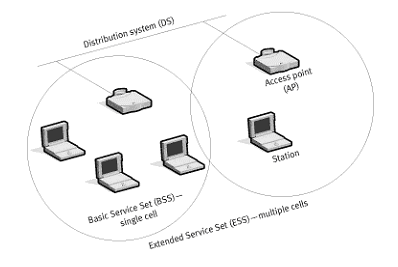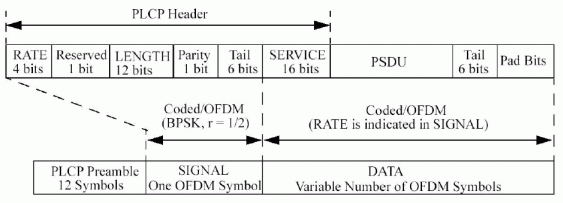
 |
Wireless CommunicationChapter: Network Concepts and Standards, 802.11 WLAN |
contributed by Paul Vrancken, CoSiNe, Philips Research
Wireless Local Area Networks (WLAN’s) are becoming more and more a crucial component in computer networks. There exist a number of standards for WLAN's and today the IEEE 802.11 family, released in 1997, is the most widely spread WLAN standard. Other standards are the High Performance European Radio LAN (HiperLAN) and HomeRF. The latter focuses mostly on wireless networks in homes.
WLAN was originally designed to have the same behavior and functionality as any IEEE wired LAN. This is difficult considering the fact that the medium is an uncontrollable space instead of a wired network. Hence security is a big problem. The main problem, however, is interference. As all nodes in a wireless network share the same medium, the nodes might hear traffic on adjacent links and interference is inevitable. Moreover, as IEEE 802.11 standard operates in unlicensed bands, it must also cope with interference from other devices operating in this band, such as microwaves, DECT phones and Bluetooth-enabled devices. To overcome this interference problem, the IEEE 802.11 standard uses a protocol called Carrier Sense Multiple Access with Collision Avoidance (CSMA/CA) to coordinate the usage of the shared medium.
The 802.11 architecture is comprised of several components and services that interact. The basic component of a IEEE802.11 WLAN is the station (STA), which connects to the wireless medium. An STA can be either a mobile station or an access point (AP). A set of mobiles together with an AP forms a Basic Service Set (BSS). The AP is the connection between the BSS and the outside world. A set of BSSs forms an Extended Service Set (ESS). The APs are the backbone of the network and communicates via an abstract medium called the Distribution System (DS). However, the IEEE802.11 standard does not specify the details of the DS, instead it specifies a set of services. The DS can be any connection between the APs as long as it provides these services.

This standard includes specifications for the two lowest levels in the OSI networking stack: the Physical Layer (PHY) and the Medium Access Control (MAC). The IEEE 802.11 standard is designed to operate under the IEEE 802.2 Logical Link Control (LLC). The purpose of the LLC is to make the layers above independent of the layers below. Thereby, the higher levels do not need to be concerned about what type of media that is used for the actual data transmission. In addition to the original 802.11 PHY, different faster PHYs are defined within 802.11a, 802.11b and 802.11g.

In
conjunction with the PHY Task Group one common MAC for Wireless Local Area
Networks (WLANs) applications has been developed. The IEEE 802.11 MAC is the
second layer in the OSI stack. It contains functions to provide reliable data
delivery, to control the access to the shared medium and to protect the data
delivered.

The interaction between the MAC and the PHY is handled by the Physical Layer convergence Protocol (PLCP). Using this PLCP the MAC Protocol Data Units (MPDU) are mapped into PLCP Protocol Data Units (PPDU). This is done to make the data suitable for sending and receiving over the wireless media using the Physical Media Dependent (PMD) sub layer. The PPDU consists of a PLCP preamble, a signal part and the data.
802.11 provides three different PHY definitions: Both Frequency Hopping Spread Spectrum (FHSS) and Direct Sequence Spread Spectrum (DSSS) support 1 and 2 Mbps data rates. Extensions to the 802.11 architecture (802.11a and 802.11g) define different multiplexing techniques that can achieve data rates up to 54 Mbps. Another extension to the standard (802.11b) defines 11 Mbps and 5.5 Mbps data rates (in addition to the 1 and 2Mbps rates) utilizing an extension to DSSS called High Rate DSSS (HR/DSSS).
The next page will give a more detailed explanation on the 802.11 MAC and it's associated mechanisms.



![]()
Wireless Communication
©
1993, 2004.